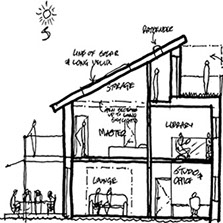number 39 is a design practice passionate about the use of space, light and sustainable materials to create beautiful, highly effective, low carbon renovations, new builds, developments and commercial projects.
call in at number 39
From first design thoughts, to planning and building drawings, to grand design aspirations:
Thinking of a project; need help creating space; aspiring to build sustainably?
Services
Our process
Planning permission design process
1: Initial Consultation
We meet to discuss your project aspirations, design ideas, budget targets and what potential land value / final build value could be realised.
And for smaller projects, whether your project would require planning permission. Not all developments need it, as some minor improvements are considered "permitted developments".
2: Preliminary Design and Feasibility Study:
A: Planning application
We will work with you to understand and develop the maximum potential of your project, creating a preliminary design and feasibility study to give you an overview of your project's viability in relation to local planning policies and site constraints.
B: Planning application + Option agreement
If you are looking to create the right kind of sustainable design project and investment value for your plot, or part of, with number 39 we can do this with you to also find the right kind of buyer.
3: Pre-application Advice
Prior to submitting a full formal planning application, seeking pre-application advice can be very useful for gaining an understanding on how your application could potentially be regarded by the local council. As well as for any potential issues that could arise.
4: Detailed Design
Based on pre-application advice feedback, our feasibility study and your approval to proceed, number 39 will then work to develop a detailed planning permission design proposal. And upon a successful decision, act also as a solid platform of outline information ready for a subsequent Building Regulations submission.
5: Planning Application Submission
We will then work complete all the required architectural drawings, visualisations, photographs and application form; as well as prepare / commission all the necessary accompanying documents, such as:
• Planning Statement
• Design and access statement
• Tree Survey / Arboriculture Impact Assessment
• Ecological Survey
• Land Contamination Assessment
• Transport Statement / Assessment
• Noise Assessment
• Community Infrastructure Levy (CIL) form
6: Planning Review
The local planning authority will review your application. This typically takes eight weeks for minor applications and thirteen weeks for major applications. They will consider the proposed development's impact on the surrounding area, local infrastructure, and any comments made by your neighbours or local community.
7: Planning Decision
Once the review is complete, the planning authority will either grant or refuse permission. If refused, they should provide reasons for their decision. In some cases, you may be able to revise your plans to address the issues raised and resubmit the application.
8: Appeal (if necessary)
If your application is refused, you have a right to appeal to the Secretary of State within six months of the decision. You should consider this option carefully with your architect as it can be a complex and lengthy process.
Remember, it's crucial to work closely with your architect throughout this process. They will help you understand the planning policies and regulations that apply to your project, making the application process as smooth as possible.
Full design process
Incorporating the above planning permission design process the Royal Institute of British Architects (RIBA) sets out 7no distinct design stages for design and build projects [of any size] towards ensuring best practice, efficiency and project success:
1: Preparation & Brief:
Development of objectives, outcomes, aspirations, budget, feasibility and site information.
Agree schedule of services, appoint design team / principal designer and conduct initial pre-planning application discussions. And inform client of regulatory and health and safety responsibilities.
2: Concept design:
Development of outline proposals, structural design, services, systems, outline specifications
along with preliminary cost information, project strategies and finalisation of project brief.
3: Developed design:
Coordinated structural design proposals, services, systems and outline specifications.
As well as cost information and project strategies outlined in stages 1 & 2. And submission of planning application / third party consultations [where required].
4: Technical design
Preparation and issue of all technical, architectural, structural, services and specialist contractor designs and specifications and project strategies including building regulations and any other third party consent submissions in accordance with stages 1/ 2/ 3 above known as 'the design programme'.
5: Construction
Offsite manufacturing and onsite construction and resolution of queries as they arise. Plus administration of the 'building contract' up to 'practical completion' including regular site inspections and progress reviews.
Collate 'Health and Safety File' and comply with any construction-specific planning conditions.
6: Handover
Handover of building and conclusion of contracts.
Comply with and advise client to comply with pre-occupancy and in-use planning Conditions.
7: Post occupancy
Though not [yet] a required aspect of building regulations; undertaking a periodic review of how your project is performing in terms of it's services and systems and even it's general use will allow you regular opportunity to ensure best performance and continuing cost effectiveness. As well as continue to add to national and indeed international best practise knowledge for effective well designed built environments.
Photo by Ryan Ancil
FAQs
Do I need an architectural professional?
Yes. For best potential results. While certainly you could develop the principles of your design ideas yourself, arguably an architectural professional's knowledge, years of experience and design expertise will ultimately generate far greater potential, creativity and value to best assist you in developing the best possible design and construction solutions for your needs.
What is an architectural designer?
At number 39 our 25+ yrs of practice allows us to be able to offer a full spectrum of architectural design services, only enlisting other expert consultants such as a structural engineer as and when required, ultimately ensuring you the most cost effective process.
Do you need planning and / or building regulations?
Not always. But you should always check / seek professional advice.
While a good builder should be able to tell you whether or not you would require appropriate approvals; you should always also confirm with your local authority or an architectural professional prior to commencement of any works.
Permitted development
Though certain minor building works will not require any permissions at all, the complexity or extent of works may still require a 'certificate of lawfulness' from your local authority. You should always check.
How long does a planning or building regulations application take?
Following completion of initial design stages, at
number 39 we advise that it would be prudent to allow not less than 16wks for any one local authority decision.
Why so long?
Searching on the internet will tell you that most planning [and building regulations] applications are required to be decided within eight weeks, (unless unusually large or complex). In which case the time limit is extended to 13 weeks. Your local authority should be able to give you an idea about their likely timetable.
In addition however to the standard 'statutory period' of 8wks for determining a local authority decision, it can and more commonly does also often take as long [or longer] for an application to be first deemed 'valid'; meaning: checked to confirm if all required elements have been satisfied and are present.
As such [particularly now in respect of the combined impacts both Brexit and Covid19] extended validation and decision time expectations are often now the norm [sadly] rather than the exception across the entire UK.
Can planning & building regulations applications be submitted at the same time?
In theory, yes. Though it is not advisable in practise in most cases. Doing so could incur considerable risk of aborted design work and other costs, even with seemingly strong existing precedent or pre-planning advise.
Photo by Sven Mieke
design@number39.co.uk
+447940925738







